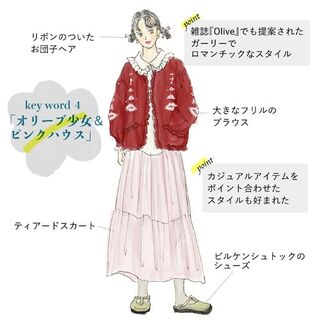Otome is a girly and romantic style that originated in the late 1970s and is often referred to as one of the predecessors of lolita fashion. It includes a wide variety of fashion styles, including Pink House Style and fashion styles from the Olive magazine.
Otome is also used to describe an inaccurate, yet similar style, of casual lolita, by western communities, Otome (Western).
The Name
Otome (乙女) is the Japanese word for "maiden" and originally referred to a maiden-like fashion and lifestyle with a focus on traditional girl's hobbies. [1] However, the usage of the term fell out of favor in Japan once it started to be associated with otaku culture in the latter half of the 90s. [2] While versions of otome still exist to this day, most are now referred to under different names and tags (such as Pink House Style.)
History
In 1982, the publisher Magazine House launched the magazine "Olive." This magazine showcased female fashion trends in Japan. One year later, Tsumori Chisato relaunched the magazine featuring a few different styles prominently, one of which had a romantic, girly, and unique design. The trends featured in Olive gave birth to the otome style (乙女スタイル) and it turned into a major trend.
Similarly, around the same time, the company Pink House had been releasing dreamy wear with ribbons and lace. This girly style was also very popular, and the brand became a popular choice for those who wore otome style, alongside imitating the style found in Olive magazines, which had a similar feel. [3][4]
Style Basics
The main features of classic otome fashion are cute clothing that is deliberately designed to make the wearer appear maiden-like. Different from other fashions, there are no strict guidelines.
In general, otome outfits strive to archive a look that appears like a "refined young lady" and the clothes often give off a girly feel. The style follows a 'feeling' or influence, rather than a set of rules. It drew inspiration from a number of sources, including hyper girly brands like Pink House, and more simple girly outfits displayed in 1980s editions of Olive magazine. Therefore, looks can vary greatly. [3][5]
Otome can be considered a part of the larger Ametora umbrella, although it is not as directly related as other fashion styles.
Modesty
The style is modest for the most part. The clothes often have bright patterns, but this is more a nod to a 1970- 1980s kitsch look, as well as the occasional nod to 1950s and 60s fashion, but with a decidedly 80s twist. Dresses, skirts and shorts can be short in length, due to the vintage influences, but these shorter items are not meant to look sexy.
Color Schemes
Bold colors and mismatching patterns are very common in this style. However, neutrals and non-patterned pieces are also common to Otome. Perfectly matching colors are not seen as something of importance. It is acceptable to keep colors "in the family" and not the exact same shade or tone as each other. Matching colors are seen as acceptable, just not as common.
Hairstyles
Hairstyles are as varied as the fashion itself. There is no limit to what styles or colors are acceptable, but natural hair colors (variants of black, brown, blonde and red) are most commonly seen paired with the style. Braids and bobs are both popular hairstyles for Otome.
Makeup
Makeup is often either natural or highly influenced by vintage makeup styles. False freckles and intense blush are used often for editorial shots in magazines but are not often worn for day-to-day outfits.
Accessories
Accessories are usually kept simple, but there is no limitation to how many may be worn.
Shoes
Shoes are usually kept to mary jane, Oxford, and simple heeled styles, but sandals and flats are also worn with the style. Shoes paired with the style can be both plain and simple or very bright and outlandish. Brown shoes and glitter shoes are both commonly worn with Otome.
Brands & Shops
- Atsuki Onishi
- Axes Femme
- F.i.n.t
- Honey Mi Honey
- Jane Marple
- Merrybelle
- MILK
- Miss Patina
- Pink House
Gallery
External Links
- ↑ Kaori Shoji. "Japanese women staying in touch with their inner virgin." The Japan Times. May 24, 2002. Retrieved August 26, 2020 from https://www.japantimes.co.jp/life/2002/05/24/language/japanese-women-staying-in-touch-with-their-inner-virgin/#.XEzW0DBCeUk
- ↑ "Girls' Culture - Contemporary Girls' Culture (translated title)." Wikipedia. (October 24, 2018). Retrieved August 26, 2020 from https://ja.wikipedia.org/wiki/%E5%B0%91%E5%A5%B3%E6%96%87%E5%8C%96#%E7%8F%BE%E4%BB%A3%E3%81%AE%E5%B0%91%E5%A5%B3%E6%96%87%E5%8C%96
- ↑ 3.0 3.1 Kai Nagase. "The Magazine “Olive” Made Japanese Girls Aware of The Rare Value of Girlhood and Maidenhood." Tokyo Girls Update. June 18, 2016. Retrieved August 26, 2020 from https://tokyogirlsupdate.com/kawaii-2-0-theory-vol-6-20160694637.html
- ↑ "Otome and the Otome Bible Olive (translated title)." Pluto Tsushin. March 3, 2013. Retrieved August 26, 2020 from http://pluto.cocolog-nifty.com/main/2013/03/olive8090-5969.html
- ↑ TOKYO STREET FASHION and CULTURE: 1980 - 2017. Google Arts and Culture. Retrieved August 26, 2020 from https://artsandculture.google.com/exhibit/tokyo-street-fashion-and-culture-%C2%A01980-2017/ogKCPmGdPtB7Iw










